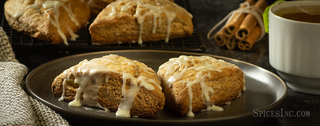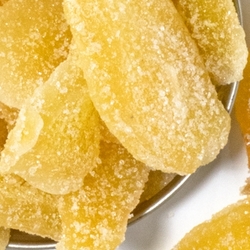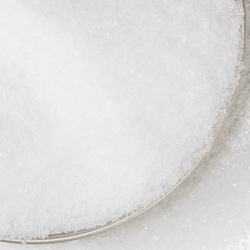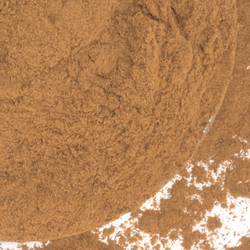Cinnamon Scones
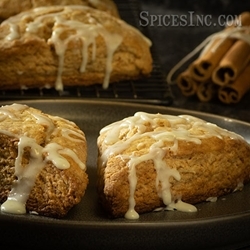
Scones get a bad rap. They’re often looked upon as dense carb-loads that sit hard in the belly and induce naps. What’s true is they do rely on hearty ingredients—they don’t shy away from butter and heavy cream—when scones are made correctly, they are airy and crumbly, with just the right blend of sweetness to lighten up the butter. The secret? Chemistry!
First, start flavoring the cream with crystallized ginger. The crystallized ginger doesn’t steep for a very long time in the cream, but if you’d prefer a stronger ginger flavor, you can combine them together early and let them mingle. We understand if your instinct is to cut the candied ginger before steeping it in the cream, but candied ginger is extremely sticky. It’s a bit more messy to cut after it’s been in the cream, but even with the mess it’s easier to cut, because the cream on the outside of the ginger helps keep the knife moving. You can chill the cream in the fridge while it steeps, to maintain an overall lower temperature for the scones, especially if you’re going to make these in warmer weather. As you’ll see, cooler ingredient temperatures are important when making an airy scone.
Keeping a scone light depends entirely on keeping your butter cold. Cold butter incorporated in a dough will steam in the oven’s heat, opening up air pockets that keep the dough fluffy. Warm butter will essentially fuse into the flour, hydrating it in buttery fat. This sounds like a good thing, but in practice it creates a dense product. To give your butter a chance to get good and cold, put a stick in the freezer the night before you plan to make the scones. Grate it across the large holes of a box grater, and stir chilled, grated butter directly into the flour.
Butter should be cut quickly into flour. Use two knives to break the butter into small, floury pearls, or work quickly by running it between your fingers. You don’t want to overwork the dough here. The heat of your hands can melt the butter and make a dense dough, so let the butter and flour just come together and stop mixing. Stir in the chopped ginger and again, just stir to evenly combine. Mixing too vigorously, which is a wordy way to say “kneading”, can initiate the formation of gluten, which will toughen the scones. Put this back in the fridge to allow butter to firm up again. Leave it fairly loose in the mixing bowl, not compacted into a ball, to allow the most amount of surface area to be exposed to the cool air.
After the dough has been refrigerated again, press it quickly into a ball and then pat it gently into an 8-inch disc, avoiding any pulling or twisting or kneading. Once they’re cut, put them back in the fridge one last time. This is to give the butter as much pep as possible in the heat of the oven.
Icing can be mixed at the last minute, since that’s not dependent on cooling or heating. You can make it as thin or as thick as you’d like. We wanted ours on the somewhat-thin side, since our intention was to drizzle it, not layer it on in a thick coat. Scones are sweet but not overly so; we didn’t want a thick, sugary topping to alter the flavor that much.
These scones have terrific balance. They’re rich and light, elegant and homespun. Once cooked, they hold together well, but offer a fun crumble. Crystallized ginger adds a touch of heat and a chewy texture. And the bottom edges that caramelize a bit in the oven? They’re exquisite. Enjoy them with a cup of tea for a light breakfast or a cozy afternoon snack.
- 1/4 cup Crystallized Ginger
- 3/4 cup heavy cream, divided
- 2 cups AP flour
- 1/2 cup sugar
- 1/2 teaspoon Fine Sea Salt
- 2 1/2 teaspoons baking powder
- 1 stick (1/2 cup) butter, frozen
- 1 egg
- 1 1/2 teaspoons Pure Vanilla Extract
- 1 1/2 teaspoons Ground Cinnamon, divided
- 1 1/4 cup powdered sugar
- Zest of one medium lime
- Pour the heavy cream over crystallized ginger. Let the two items steep together while you prepare the scones.
- Whisk together all dry ingredients (flour, sugar, salt, baking powder).
- Grate frozen butter into dry ingredients. Mix together, either using your fingers or two knives, until flour and butter have come together into crumbly pieces roughly the size of small peas.
- Put the flour and butter back in the freezer while you prepare the wet ingredients.
- Drain ginger, reserving the heavy cream. Chop into small pieces.
- Measure 1/2 cup heavy cream, setting remainder aside for later use. Whisk 1/2 cup cream with 1 egg, vanilla extract, and 1 teaspoon cinnamon.
- Remove flour mixture from freezer. Pour wet ingredient mix over flour mix; stir to evenly incorporate. Then stir in chopped crystallized ginger.
- Working quickly, roll all ingredients into a ball, then flatten into an 8-inch disc. If it is too wet and sticks to your hands, add more flour. If it is too dry and crumbles instead of flattens, add a small amount of cream.
- Cut into 8 wedges. Put on a parchment-lined baking sheet. Brush tops of scones lightly with cream and put back in the fridge for 15 minutes.
- Preheat oven to 400°F.
- Once scones have set up in the fridge, get them in the hot oven and bake for 20-25 minutes, until they are lightly browned all over.
- While scones are baking, make icing by stirring powdered sugar together with remaining cinnamon, two Tablespoons heavy cream and zest from one lime. If icing is too thick, add more cream, or some fresh lime juice, in small increments until it is the desired consistency.
- Remove scones. Let cool at least 1 hour, and then drizzle with icing.

